Method for screening G-quadruplex ligands on basis of photoinduced electron transfer
An electron transfer, quadruplex technology, applied in biochemical equipment and methods, microbial determination/inspection, etc., can solve problems such as the inability to obtain effective data in the detection form, and achieve easy promotion, low toxicity and side effects, and strong biological activity. Effect
- Summary
- Abstract
- Description
- Claims
- Application Information
AI Technical Summary
Problems solved by technology
Method used
Image
Examples
Embodiment 1
[0028] With emodin and matrine as traditional Chinese medicine monomers, the method for screening G-quadruplex ligands based on photoinduced electron transfer (PIET) consists of the following steps:
[0029] (1) Add hairpin DNA (F-hpDNA, the sequence of F-hpDNA is 5'-FAM (carboxyfluorescein)-TAGCCCTTAGGGTTAGGGTTAGGGTTAGGGCTA-3') with 20mmol / L tris-hydrochloric acid at pH=7.4 Buffer solution to prepare a hairpin DNA solution with a concentration of 100 μmol / L, and put it in a refrigerator at 4°C overnight;
[0030] (2) Dilute the concentration of the hairpin DNA solution in step (1) from 100 μmol / L to 50 nmol / L with 20 mmol / L tris-hydrochloric acid buffer solution with pH=7.4, and take 400 μL of concentration as 50 nmol / L The hairpin type DNA solution is added in 16 wells of 96 well plates, and the initial fluorescence intensity value I in each well is measured with a fluorescence spectrophotometer 0 ;
[0031] (3) add 1 μ L 4mmol / L emodin solution again in 8 holes of step (2...
Embodiment 2
[0033] The method for screening apigenin based on photoinduced electron transfer (PIET) consists of the following steps:
[0034] (1) Add hairpin DNA (F-hpDNA, the sequence of F-hpDNA is 5'-FAM (carboxyfluorescein)-TAGCCCTTAGGGTTAGGGTTAGGGTTAGGGCTA-3') with 20mmol / L tris-hydrochloric acid at pH=7.4 Buffer solution to prepare a hairpin DNA solution with a concentration of 100 μmol / L, and store it in a -20°C refrigerator;
[0035] (2) Dilute the concentration of the hairpin DNA solution in step (1) from 100 μmol / L to 50 nmol / L with 20 mmol / L tris-hydrochloric acid buffer solution with pH=7.4, and take 200 μL of concentration as 50 nmol / L The hairpin type DNA solution is added in 8 wells of 96 well plates, and the initial fluorescence intensity value I in each well is measured with a fluorescence spectrophotometer 0 ;
[0036] (3) add 1 μ L 4mmol / L apigenin solution again in 8 wells of step (2), make its final concentration in the reaction system be 10 μ mol / L, measure the fluo...
PUM
 Login to View More
Login to View More Abstract
Description
Claims
Application Information
 Login to View More
Login to View More - R&D
- Intellectual Property
- Life Sciences
- Materials
- Tech Scout
- Unparalleled Data Quality
- Higher Quality Content
- 60% Fewer Hallucinations
Browse by: Latest US Patents, China's latest patents, Technical Efficacy Thesaurus, Application Domain, Technology Topic, Popular Technical Reports.
© 2025 PatSnap. All rights reserved.Legal|Privacy policy|Modern Slavery Act Transparency Statement|Sitemap|About US| Contact US: help@patsnap.com



